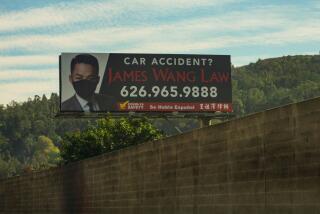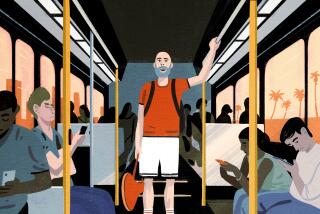There’s curb appeal, then there’s a curbside appeal
- Share via
Bus benches just don’t get much respect. Some are slept on; some are defaced by graffiti. Coffee and soda are spilled on them. Names are engraved. And yet . . .
In today’s Web-surfing, GPS-navigating, digital camera-snapping, blog-dominated universe, the lowly bus bench is for some real estate agents a beacon of marketing optimism, a way to stand out amid the clutter of high-tech ads.
Sure, they’re pedestrian, but that’s exactly the point, according to the advertising agency that brought us the iconic “Got Milk?” campaign and made wearing a chalky mustache en vogue.
“You can get 100,000 cars passing by a bench on Sepulveda or Wilshire [boulevards] every day,” said Joshua Spanier, director of communications strategy for San Francisco-based Goodby, Silverstein & Partners. “That’s a lot of opportunity . . . for people to see your message.”
What is that message, exactly? “I’m here! Remember me when you buy in this neighborhood!” It’s about name recognition on a micro level.
“You have about 2.3 seconds” to get motorists’ attention, estimates George Kubota, a sales representative for Irvine-based Atomic Outdoor Media, which buys bench space for clients. He added that although the first drive-by may not register, the agent’s name will after it’s viewed three or more times in quick succession over several weeks.
“Repetitive bench ads are like those radio mattress ads,” he said. “They get stuck in your head.”
They’re also “about perception,” said Whit Prouty, a Studio City Keller Williams Realty agent and bench-ads enthusiast. He said the ads imply, “ ‘I’m spending money on marketing, so I must be successful.’ Benches do a number of things for me.”
Not all of those things relate to realty. Or maybe they do. Prouty recalled the year his family’s holiday greeting cards featured a photo of his wife, three kids and their dog seated next to his mug shot on one of his bus benches. “Our friends got a kick out of it,” Prouty said. It probably didn’t hurt business, either.
The standout factor
And, unique to this particular advertising niche, bus benches aren’t surrounded by the clutter of credit card and pharmaceutical ads that typically bombard online users. Yes, there is the occasional neighboring bench with a high-volume lawyer seeking to add to his DUI client roster, but for the most part, bus bench ads are the Mr. Cleans of advertising.
But the biggest reason bus bench ads work, according to Carol Scott, a UCLA professor of marketing, is that as we drive by in a state of traffic catatonia, our minds are ready to record. “We’re in a greater state of receptivity when we’re not in front of our computers. People stopped at a light, with nothing to do, see a name and it registers.”
Seeking a way to stand out in his neck of the realty kingdom, Northridge Re/Max Olson & Associates agent David Rothblum decided to buy bench ads after trying marketing at mall kiosks, car washes, on the Web, in newspapers and through mailed brochures -- strategies he still uses. So four months ago he pasted his face on four benches in Universal City, Sherman Oaks and North Hollywood. And voilà : “I got a ton of calls.”
“It’s funny. People say, ‘I’ve seen your bench,’ and they chuckle,” Rothblum said. “It’s a different way of advertising. But for me, the bottom line is that they saw it.”
“Seeing it” apparently promotes a feeling of familiarity too. Agents say that strangers often approach them, insisting that they’re long-lost friends or high school chums from 30 years ago.
“We were in Mammoth once, and some people approached us and said, ‘I’m sure I know you!’ ” said Eileen Moreno, a Re/Max Los Feliz-Silver Lake agent. Her husband, George Moreno, is her business partner. “They didn’t believe us when we said they didn’t. We assumed it was because of our benches.”
Mike Culver, president of Gardena-based Coastline Street Advertising, who estimates that 90% of his bench ads go to real estate agents, tells the story of a Pico Rivera client who purchased bench ads from him for 15 years. About five years ago, city officials removed the ads, Culver said. The client told Culver that despite the half-decade advertising absence, strangers still stop him on the street, claiming they just saw him on benches.
“How else can you get famous for a low price in one target area?” Culver asked.
Coastline charges $200 a bench per month in most areas; the lowest-priced benches are $125 (plus production costs). Bigger companies also charge $200 a bench per month but typically require a five-bench, four-month minimum.
Just like real estate, bus bench ads are all about location: East L.A., Whittier, Carson and South L.A. benches cost less than those in the Valley and on the Westside.
Popular L.A. locations, vendors say, are Wilshire Boulevard in Westwood, Abbot Kinney Boulevard in Venice, and the streets of Marina del Rey and West L.A.
In Studio City, Sherman Oaks and most of the Westside, bench space is competitive and only becomes available every two to three years, if that, bench ad providers say. When they are, they’re grabbed quickly.
There are 6,500 bus benches with commercial ads in L.A. In California, about 10% of benches are used for realty advertising, according to Kubota. The goal of agents is to maintain a subtle, but clear, presence in their selling neighborhoods.
“It’s branding, like Coca-Cola or Adidas,” Kubota said. “The more those people see them, the more the name sticks.”
Roadside recognition
Branding is the No. 1 reason agents cite for purchasing bench space in a state with half a million licensed real estate agents.
Eileen and George Moreno, the Los Feliz Re/Max agents, have bought eight benches a year since 2004, spending about 5% of their ad budget on them. George Moreno said that most clients come from other forms of advertising, but “some new clients do call us. Our idea is that one call can make a difference.”
Most agents don’t track data about the percentage of clients they’ve gotten from bench ads but do say they receive a steady stream of phone calls from people who first encountered their names on a bus bench. Because of this response, they swear by the marketing tool, even though they know the exposure to motorists is quick.
Although simple, bench ads, like all marketing, must reach the right audience and help the consumer understand what’s for sale, said ad agent Spanier. Benches are ripe for the bizarre and tacky, so he recommends that advertisers use appealing typesetting, make the ads readable and say what needs to be said without being disruptive or creating an eyesore.
“Everyone wants 15 different things on one ad, forgetting that people are driving by at 20 miles per hour and can’t read it all,” Spanier said. “Keep it simple: name, website, local number. Be absolutely clear and keep in mind that less is more.”
Taking that idea to its smallest conclusion, Bill Toth, a Burbank agent at Windermere-Bill Toth & Associates, has, for the last 10 years or so, bought ad space on the child’s seat of every shopping cart at a Vons market in Burbank.
“Bus benches are great; shopping carts are even more personal,” Toth said. He’s had to suffer the occasional indignity of devil horns and mustaches on his well-coiffed mug, but he takes it in stride.
“The bottom line in this business,” Toth said, “is that you just want to be known. No matter how you do it, being well-known is a good thing.”
--
More to Read
Inside the business of entertainment
The Wide Shot brings you news, analysis and insights on everything from streaming wars to production — and what it all means for the future.
You may occasionally receive promotional content from the Los Angeles Times.










